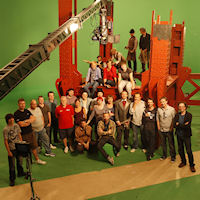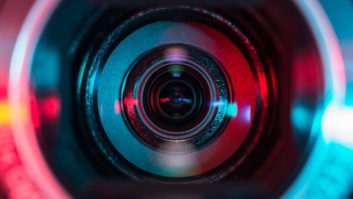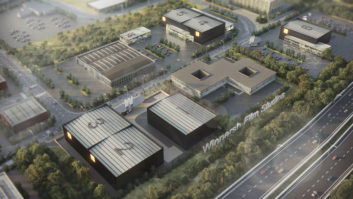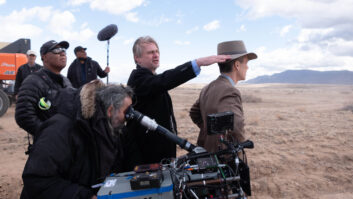
A new leisure attraction at Blackpool’s iconic tower features a 4D experiential film that includes more effects than any other produced by Merlin Entertainments, including that at the London Eye. Director Michael Hall and stereographer David Cox explain how it was done.
The four-minute film takes the audience on an aerial journey over Blackpool and surrounding regions in the company of a young boy. It was produced by Sharp Cookies and commissioned by Merlin Entertainments as part of a major regeneration project for Blackpool seafront which opens on 1 September.
“The film contains the most 4D effects put into any of our cinemas,” said Craig Sciba, project designer at Merlin Studios’ design department. “We have snow, wind, rain, fog, explosions, scent and of course stereo 3D.”
Filming processes included green screen composites, graphic design, 3D camera tracking, set extensions, and object removal such as safety wires and CGI integration. The finished piece has a 7.1 surround sound mix.
“The storyboard we pitched last August is 90% of what is in the finished project,” said Sharp Cookies’ Director Michael Hall. “We created an animatic in 3D for the pitch accompanied by a 5.1 surround sound mix and took the client to a 3D viewing room and showed them the timings we wanted to use as well as the 4D effects. I wanted to win the project.”
Since the Blackpool promenade was being renovated and the tower itself covered in scaffolding, models were made of the tower and shot against green screen. Sequences include a circus, the famous Blackpool ballroom, a lifeboat chase and an aerial shot of motorcycle rider Guy Martin in the recent TT Races on the Isle of Man.
It was shot on two Red MX cameras mounted on an Element Technica Quasar rig. The cameras, lenses, rig, rig technician, DIT and playback devices were supplied by On Sight. Aerial shots of the town, the Isle of Man and the Lake District were shot using a helicopter gyro stabilized C-Stab.
“We tested Arri cameras and Reds side by side and opted for the Reds because we felt the output of the ProRes from Arri gave us less resolution than the Red 4K when we needed as much as resolution as possible because of the amount of green screen and compositing we were planning,” said Hall.
They chose zoom lenses rather than primes, even though conventional wisdom is that for shooting 3D, prime lenses provide a better match between the two images, as zooms invariably zoom the left and right images slightly differently. “Since the post workflow was being carried out on SGO Mistka, we were confident in its ability to rapidly align the left and right images and so remove any mismatches from the lenses,” explained project stereographer and post supervisor David Cox. “The benefit of this is that we could shoot much more quickly, because changes in framing didn’t require lens changes and rig re-construction. This was important because we were shooting with children, but in fact we finished ahead of schedule every day and were even able to shoot many ‘bonus’ takes.” The post workflow featured Mistika at the start and end of the process; preparing the rushes for offline at one end and creating visual effects and grading at the other. All rushes from the Reds were taken straight to Mistika before offline editing in Final Cut. Mistika was then used to pair up the left and right images, match the geometry and colour of the two and provide files for offline that were easy for the editor to handle. “Mistika’s equaleyes function meant that syncing and aligning some four hours of rushes took less than an hour,” explained Cox. “It also meant that as successive edit lists came from the editor, Mistika allowed these to be conformed against the aligned rushes, which in turn had further grading and post work carried out while the editor was working. The whole rushes prep and editing workflow became extremely efficient this way. “We took the original drawn story board into Mistika and cut each shot into different layers so we would present and consider the effect of stereo 3D on the project,” he said. “This is an ‘experience film’, so the 3D becomes a character in its own right. As with all characters, there are times when it is the star and times when it should be in the background. Across shooting and post, the amount and position of 3D was carefully controlled, so for example when the expressions of the child actor are the key messages from a scene, the 3D is subtle and not over-powering. “On the other hand, carefully orchestrated ‘3D moments’ are placed through the film which will make the audience duck or reach out to touch hovering objects. Since the film is so short, it is possible to dial up the 3D effect without causing viewer fatigue, but it is still vital to carefully limit and manipulate the 3D so effects are strong but not uncomfortable. This usually means carefully linking the stereoscopic aspect of 3D with other depth-cues such as focus, brightness and perspective.”
The DOP is Adam Hall, Matt Wynne, VFX supervisor and art director and the editor is Matthew Hall.
4D may feel state of the art but there are a number of 5D attractions emerging. The fifth element could be the result of cinemas placed in unusual environments (such as water theme parks) or employ image mapping in which the audience is surrounded by projections; or utilise seats capable of moving in-sync with the pictures.
Sciba believes true 5D is more about audience interaction with the screen and that this is on its way.
“We have moved from colour to digital HD to 3D and now 4D is the next big progression. Beyond 4D we want to take audiences on an interactive ride where the decisions they make alters the effects they feel or the direction of the film they see.”






